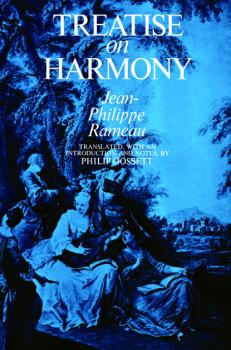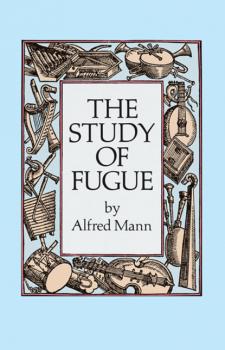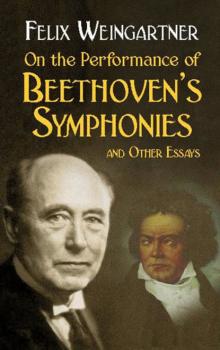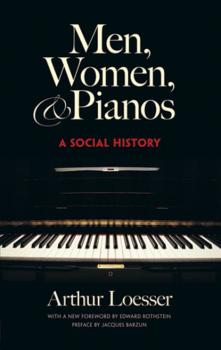ТОП просматриваемых книг сайта:















Dover Books on Music
Скачать книги из серии Dover Books on MusicАннотация
The Traité de l'harmonie of Jen-Philippe Rameau is one of the most important books in the history of Western music. Written while Rameau was still a relatively obscure organist and music master at Clermont-Ferrand, the book received but one printing during Rameau's life, in 1722, shortly before he settled in Paris. The Traité was immediately recognized as a profound advance in musical theory, however, and it established Rameau's reputation as a theorist. His book was the first to codify those principles of tonality that were to dominate the music of the West for almost two centuries. Even today the theories of Rameau remain the basis for the study of harmony.Rameau's Traité de l'harmonie is divided into four books, the first of which presents the mathematical basis from which Rameau sought to derive his theories. Book Two may be considered the most important section of the Traité; in it Rameau generates his entire harmonic system from fundamental principles, explaining intervals, chords, and modes — everything, in fact, essential to musical composition in tonal style. Working from the principles developed in Books One and Two, Book Three treats the practical rules of composition, including such topics as harmonic modulation and chord progressions. Book Four concerns the practical art of accompaniment on harpsichord or organ, including the realization of a figured bass. Corrections added by Rameau in a supplement are included in the text, and all the musical examples have been reset in modern musical notation. In addition, two pages from a unique copy of the first issue of the first edition are given in facsimile. The translator's introduction discusses the history of the work, Rameau's mathematics, and his place in the history of music theory.
Аннотация
Classic study comprises two parts. The first is a comprehensive historical survey of writings on the fugue from the beginning of fugal teaching (c. 1350) to the present. Part Two explores in depth four 18th-century studies which are its classical presentations: Steps to Parnassus, J. J. Fux (1725), A Treatise on Fugue, F. W. Marpurg (1753–54), Fundamental and Practical Essay on Fugal Counterpoint, Padre Martini (1775), A Manual of the Fundamental Principles of Composition, J. A. Albrechtsberger (1790). Translations of texts, introductions and critical commentary, and many musical examples. Index. Bibliography.
Аннотация
The greatest Renaissance creator of liturgical music, the revered sixteenth-century composer known as Palestrina wrote works that served for centuries as models of counterpoint. Until The Style of Palestrina and the Dissonance, theoreticians seldom closely analyzed the composer’s work to discover its fundamental elements, including the handling of rhythm, line, and harmony.Beginning chapters discuss the standard use of rhythm and mensuration in Palestrina’s time, the ecclesiastical modes, and treatment of words. Author Knud Jeppesen proceeds to explore Palestrina’s music in terms of the elements that constitute his personal style, isolating unusual vertical lines and establishing common and uncommon interval skips and rhythmic accents. The heart of the book presents a modern empirical treatment of dissonance. Palestrina's contrapuntal technique forged new harmonic devices, placing dissonance on unaccented beats and highlighting text in very unorthodox ways for his time. These new uses of dissonance and resolution are explored in meticulous detail. In addition, Jeppesen includes a complete history of the evolving concept and treatment of dissonance before Palestrina, including quotations from the earliest theoretical works and numerous musical examples that illustrate the practices of Palestrina’s predecessors.
Аннотация
Fifty first-rate musical compositions document the development of musical style from the early Middle Ages to the Middle of the 18th century. Among the selections are a Gregorian hymn, an English lute piece, operatic arias, instrumental and vocal motets, a French ballad, as well as works by Vivaldi, Telemann, Pergolesi, Scarlatti, Buxtehude, and other masters. Commentary evaluates style, form and historical setting, and complete compositions or sections of compositions are supplied when possible.
On the Performance of Beethoven's Symphonies and Other Essays - Felix Weingartner
Dover Books on MusicАннотация
This volume contains English translations of three important literary works by Austrian conductor Felix Weingartner (1863–1942). The title essay is a detailed account of specific performing difficulties and questions of interpretation in each of the nine symphonies, a comprehensive treatment that will be indispensable to music students. Additional features include «On Conducting» and «The Symphony Since Beethoven,» both of which attest to the author's belief that art is at its best when an «exceedingly delicate balance is attained between the feeling and the intellect.» Weingartner's wealth of observations on music and musicians will fascinate anyone interested in symphonic traditions.
Информация о книге
Автор произведения Felix Weingartner
Жанр Музыка, балет
Серия Dover Books on Music
Аннотация
As the «social anchor» in middle-class homes of the nineteenth century, the piano was simultaneously an elegant piece of drawing-room furniture, a sign of bourgeois prosperity, and a means of introducing the young to music. In this admirably balanced and leisurely account of the popular instrument, the late, internationally known concert pianist Arthur Loesser takes a «piano's-eye view» of the recent social history of Western Europe and the United States.Drawing on newspapers, music manuscripts, popular accounts, and other sources, Loesser traces the history of the piano from its predecessors, the clavichord and the harpsichord, to the modern spinet and concert grand. Chapter headings such as «Clavichords Make Weeping Easier,» «The Harpsichord Grows Feet,» «The More Pianos the Merrier,» and «The Keyboards Go West» suggest the author's lighthearted approach to topics ranging from the piano's European origins and its introduction in the United States to the decline of piano manufacturing in the early twentieth century and the «victory of airborne music» by mid-century. A preface by historian Jacques Barzun and a new foreword by music critic Edward Rothstein enhance a volume rich in wit and knowledge — one that will delight any reader with an interest in the piano and on Western cultural history.
Аннотация
"Music is your own experience, your thoughts, your wisdom. If you don't live it, it won't come out of your horn." — Charlie Parker"What is jazz? The rhythm — the feeling." — Coleman Hawkins"The best sound usually comes the first time you do something. If it's spontaneous, it's going to be rough, not clean, but it's going to have the spirit which is the essence of jazz." — Dave BrubeckHere, in their own words, such famous jazz musicians as Louis Armstrong, King Oliver, Fletcher Henderson, Bunk Johnson, Duke Ellington, Fats Waller, Clarence Williams, Jo Jones, Jelly Roll Morton, Mezz Mezzrow, Billie Holiday, and many others recall the birth, growth, and changes in jazz over the years. From its beginnings at the turn of the twentieth century in the red-light district in New Orleans (or Storyville, as it came to be known), to Chicago's Downtown section and the Original Dixieland Jazz Band and Chicago's South Side to jam sessions in Kansas City to Harlem during the Depression years, the West Coast and modern developments, the story of jazz is vividly and colorfully documented in hundreds of personal interviews, letters, tape recorded and telephone conversations, and excerpts from previously printed articles that appeared in books and magazines.There is no more fascinating and lively history of jazz than this firsthand telling by the men who made it. It should be read and re-read by all jazz enthusiasts, musicians, students of music and culture, students of American history, and other readers. «A lively book bearing the stamp of honesty and naturalness.» — Library Journal. «A work of considerable substance.» — The New Yorker. «Some of the quotations are a bit racy but they give the book a wonderful flavor.» — San Francisco Chronicle.
Аннотация
This first comprehensive history of musical instruments, this book ranges from prehistoric times to the 20th century. It traverses five continents and every stage of evolution, from primitive rattles and bull-roarers to the electric organ. Author Curt Sachs, one of the world's most distinguished musicologists, combines rich scholarship with personal insight in a remarkable fusion of music, anthropology, and the fine arts.Beginning with the earliest manifestations of rhythm, Sachs explores the association of sound with primitive rites of fertility, life, death, and rebirth. He traces the evolution of folk and ritual instruments to tools of entertainment and art, the rise of a professional class of singers and musicians, and the musical revolution that flowered during the Renaissance. Sachs chronicles the foundation of the modern orchestra during the baroque period and its subsequent development, concluding with the modern-day rise of electric and jazz instruments.A pleasure to read as well as a valuable resource, this classic work is enhanced with 24 plates and 167 illustrations.
Аннотация
For anyone who loves to sing the great old songs, knows the melodies, but has trouble remembering some or all of the words, help is at hand in this extremely useful and unique compendium of popular song lyrics.Included are the complete lyrics for 500 well-known songs from many sources: folk songs, hymns and spirituals, nursery songs and children's play songs, patriotic and military songs, popular songs (many from Tin Pan Alley and Broadway shows), and many more.All the old favorites are here: After You've Gone, Beautiful Dreamer, Camptown Races, Danny Boy, Frankie and Johnny, Greensleeves, Home on the Range, I Love You Truly, John Henry, Kumbayah, Little Brown Jug, Molly Malone, Nobody Knows, Oh Susanna, Peg o' My Heart, Red River Valley, Shenandoah, Till We Meet Again, and hundreds more.Carefully researched, attractively printed, and sturdily bound, 500 Best-Loved Song Lyrics is the perfect companion for parties, sing-alongs, family get-togethers — anywhere people gather to sing and enjoy the great songs of yesteryear.
Аннотация
A solid grounding in musical techniques of the 17th and 18th centuries is essential to a complete understanding of Baroque music. Arnold's legendary work is a comprehensive survey of the topic, covering every issue of significance to today's performers. The text is fully amplified with numerous musical examples, authoritative citations, scholarly interpretations and syntheses, and the author's own conclusions. This rich collection of source material for the musicologist is an equally indispensable companion for conductors, editors, and performers.










